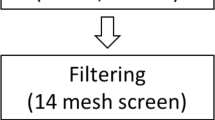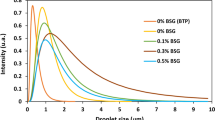Abstract
The aim of this study was to develop and characterize the mechanical, microstructural, and thermal behavior of a novel edible biphasic gel system also termed bigel. A combination of a gelatin hydrogel and rice bran wax (RBW)-based oleogel with soybean oil was used for bigel formulation. Bigels were prepared with four oleogel-to-hydrogel (OG:HG) ratios (50:50, 40:60, 30:70, 20:80) at three gelatin concentrations (5, 7, and 10% (w/w)). The RBW concentration remained constant at 10% (w/w). Bigels were analyzed using Fourier transform infrared spectroscopy (FTIR), differential scanning calorimeter (DSC), confocal laser scanning microscopy (CLSM), and small deformation rheology. CSLM images confirmed an oleogel-in-hydrogel system for all bigel formulations with an increase in oleogel proportion leading to increased oleogel droplet size and enhanced stability. Rheological characterization of the systems showed all bigel formulations, regardless of gelatin concentration and oleogel to hydrogel proportion, showed more solid than liquid (G′ > G″) character and frequency independence at 20 ℃. Bigels with higher OG:HG ratios, i.e., 50:50 and 40:60, consistently exhibited greater elastic modulus (G′) values than those of gels with lower OG:HG ratios, providing evidence of increased oleogel droplet interaction leading to enhanced mechanical properties. The rheological behavior of all bigels was accurately captured by the Boltzmann Sigmoidal model. FTIR and DSC analysis showed distinct peaks for the oleogel and hydrogel phases in all bigel samples with the absence of new thermal events, indicating a lack of interactions between components of both phases. Overall, the system is a “true” bigel that benefits from its two distinct phases and is kinetically stable.







Similar content being viewed by others
References
Andonova, V. Y., Peneva, P., Apostolova, E. G., Dimcheva, T. D., Peychev, Z. L., & Kassarova, M. (2017). Carbopol hydrogel/sorbitan monostearate-almond oil based organogel biphasic formulations: Preparation and characterization of the bigels. Tropical Journal of Pharmaceutical Research, 16, 1455–1463. https://doi.org/10.4314/tjpr.v16i7.1.
Bollom, M. A., Clark, S., & Acevedo, N. C. (2020). Development and characterization of a novel soy lecithin- stearic acid and whey protein concentrate bigel system for potential edible applications. Food Hydrocolloids, 101, 105570. https://doi.org/10.1016/j.foodhyd.2019.105570
Bollom, M. A., Clark, S., & Acevedo, N. C. (2021). Edible lecithin stearic acid and whey protein bigels enhance survival of probiotics during in vitro digestion. Food Bioscience, 39, 100813. https://doi.org/10.1016/j.fbio.2020.100813
Chen, J., & Dickinson, E. (1999). Effect of surface character of filler particles on rheology of heat-set whey protein emulsion gels. Colloids and Surfaces B: Biointerfaces, 12(3), 373–381. https://doi.org/10.1016/S0927-7765(98)00091-5
Dassanayake, L. S. K., Kodali, D. R., Ueno, S., & Sato, K. (2009). Physical properties of rice bran wax in bulk and organogels. Journal of the American Oil Chemists’ Society, 86(12), 1163. https://doi.org/10.1007/s11746-009-1464-6
Dickinson, E. (2012). Emulsion gels: The structuring of soft solids with protein-stabilized oil droplets. Food Hydrocolloids, 28(1), 224–241. https://doi.org/10.1016/j.foodhyd.2011.12.017
Geremias-Andrade, I. M., Souki, N. P. B. G., Moraes, I. C. F., & Pinho, S. C. (2016). Rheology of emulsion-filled gels pplied to the development of food materials. Gels, 2(3), 22. https://doi.org/10.3390/gels2030022
Ilomuanya, M. O., Hameedat, A. T., Akang, E. N., et al. (2020). Development and evaluation of mucoadhesive bigel containing tenofovir and maraviroc for HIV prophylaxis. Future Journal of Pharmaceutical Sciencest, 6, 81. https://doi.org/10.1186/s43094-020-00093-3
Kodela, S. P., Pandey, P. M., Nayak, S. K., Uvanesh, K., Anis, A., & Pal, K. (2017). Novel agar–stearyl alcohol oleogel-based bigels as structured delivery vehicles. International Journal of Polymeric Materials and Polymeric Biomaterials, 66(13), 669–678. https://doi.org/10.1080/00914037.2016.1252362
Lewis, T. B., & Nielsen, L. E. (1970). Dynamic mechanical properties of particulate-filled composites. Journal of Applied Polymer Science, 14(6), 1449–1471. https://doi.org/10.1002/app.1970.070140604
Lupi, F. R., Shakeel, A., Greco, V., Oliviero Rossi, C., Baldino, N., & Gabriele, D. (2016). A rheological and microstructural characterisation of bigels for cosmetic and pharmaceutical uses. Materials Science and Engineering: C, 69, 358–365. https://doi.org/10.1016/j.msec.2016.06.098
Martín-Illana, A., Notario-Pérez, F., Cazorla-Luna, R., Ruiz-Caro, R., & Veiga, M. D. (2019). Smart Freeze-Dried Bigels for the Prevention of the Sexual Transmission of HIV by Accelerating the Vaginal Release of Tenofovir during Intercourse. Pharmaceutics, 11(5), 232. https://doi.org/10.3390/pharmaceutics11050232
Martins, A. J., Silva, P., Maciel, F., Pastrana, L. M., Cunha, R. L., Cerqueira, M. A., & Vicente, A. A. (2019). Hybrid gels: Influence of oleogel/hydrogel ratio on rheological and textural properties. Food Research International, 116, 1298–1305. https://doi.org/10.1016/j.foodres.2018.10.019
Mazurkeviciute, A., Ramanauskiene, K., Ivaskiene, M., Grigonis, A., & Briedis, V. (2018). Topical antifungal bigels: Formulation, characterization and evaluation. Acta Pharmaceutica; Zagreb, 68(2), 223–233. https://doi.org/10.2478/acph-2018-0014
McClements, D. J., Dickinson, E., Dungan, S. R., Kinsella, J. E., Ma, J. G., & Povey, M. J. W. (1993). Effect of emulsifier type on the crystallization kinetics of oil-in-water emulsions containing a mixture of solid and liquid droplets. Journal of Colloid and Interface Science, 160(2), 293–297. https://doi.org/10.1006/jcis.1993.1399
Mezger, T. G. (2006). The rheology handbook: For users of rotational and oscillatory rheometers (2nd ed.). Vincentz Network.
Miyawaki, O., Omote, C., & Matsuhira, K. (2015). Thermodynamic analysis of sol–gel transition of gelatin in terms of water activity in various solutions. Biopolymers, 103(12), 685–691. https://doi.org/10.1002/bip.22706
Murata, H. (2012). Rheology—Theory and application to biomaterials. In A. De Souza Gomes (Ed.), Polymerization. InTech. https://doi.org/10.5772/48393
Navarro-Verdugo, A. L., Goycoolea, F. M., Romero-Meléndez, G., Higuera-Ciapara, I., & Argüelles-Monal, W. (2011). A modified Boltzmann sigmoidal model for the phase transition of smart gels. Soft Matter, 7(12), 5847–5853. https://doi.org/10.1039/C1SM05252G
Pal, R. (2002). Complex shear modulus of concentrated suspensions of solid spherical particles. Journal of Colloid and Interface Science, 245(1), 171–177. https://doi.org/10.1006/jcis.2001.7974
Palanuwech, J., & Coupland, J. N. (2003). Effect of surfactant type on the stability of oil-in-water emulsions to dispersed phase crystallization. Colloids and Surfaces A: Physicochemical and Engineering Aspects, 223(1), 251–262. https://doi.org/10.1016/S0927-7757(03)00169-9
Palierne, J. F. (1990). Linear rheology of viscoelastic emulsions with interfacial tension. Rheologica Acta, 29(3), 204–214. https://doi.org/10.1007/bf01331356
Paul, S. R., Qureshi, D., Yogalakshmi, Y., Nayak, S. K., Singh, V. K., Syed, I., Sarkar, P., & Pal, K. (2018). Development of bigels based on stearic acid–rice bran oil oleogels and tamarind gum hydrogels for controlled delivery applications. Journal of Surfactants and Detergents, 21(1), 17–29. https://doi.org/10.1002/jsde.12022
Reséndiz-Muñoz, J., Corona-Rivera, M. A., Fernández-Muñoz, J. L., Zapata-Torres, M., Márquez-Herrera, A., & Ovando-Medina, V. M. (2017). Mathematical model of Boltzmann’s sigmoidal equation applicable to the set-up of the RF-magnetron co-sputtering in thin films deposition of BaxSr1-xTiO3. Bulletin of Materials Science, 40(5), 1043–1047. https://doi.org/10.1007/s12034-017-1441-x
Rompicherla, N. C., Muaralidharan, A., & Sandeep, D. S. (2018). Design and evaluation of bigels containing flurbiprofen. Research Journal of Pharmacy and Technology., 11, 143. https://doi.org/10.5958/0974-360X.2018.00028.8.
Sagiri, S. S., Behera, B., Rafanan, R. R., Bhattacharya, C., Pal, K., Banerjee, I., & Rousseau, D. (2014). Organogels as matrices for controlled drug delivery: A review on the current state. Soft Materials, 12(1), 47–72. https://doi.org/10.1080/1539445X.2012.756016.
Sahoo, S., Singh, V. K., Uvanesh, K., Biswal, D., Anis, A., Rana, U. A., Al‐Zahrani, S. M., & Pal, K. (2015). Development of ionic and non-ionic natural gum-based bigels: Prospects for drug delivery application. Journal of Applied Polymer Science, 132(38). https://doi.org/10.1002/app.42561
Shakeel, A., Farooq, U., Iqbal, T., Yasin, S., Lupi, F. R., & Gabriele, D. (2019). Key characteristics and modelling of bigels systems: A review. Materials Science and Engineering: C, 97, 932–953. https://doi.org/10.1016/j.msec.2018.12.075
Shakeel, A., Lupi, F. R., Gabriele, D., Baldino, N., & De Cindio, B. (2018). Bigels: A unique class of materials for drug delivery applications. Soft Materials, 16(2), 77–93. https://doi.org/10.1080/1539445X.2018.1424638
Singh, B., & Kumar, R. (2019). Designing biocompatible sterile organogel–bigel formulations for drug delivery applications using green protocol. New Journal of Chemistry, 43(7), 3059–3070. https://doi.org/10.1039/C8NJ05480K
Singh, V. K., Banerjee, I., Agarwal, T., Pramanik, K., Bhattacharya, M. K., & Pal, K. (2014). Guar gum and sesame oil based novel bigels for controlled drug delivery. Colloids and Surfaces B: Biointerfaces, 123, 582–592. https://doi.org/10.1016/j.colsurfb.2014.09.056
Smith, J. C. (1975). Simplification of van der Poel’s formula for the shear modulus of a particulate composite. Journal of Research of the National Bureau of Standards Section A: Physics and Chemistry, 79(2), 419. https://doi.org/10.6028/jres.079a.007
Soni, K., Gour, V., Agrawal, P., Haider, T., Kanwar, I. L., Bakshi, A., & Soni, V. (2021). Carbopol-olive oil-based bigel drug delivery system of doxycycline hyclate for the treatment of acne. Drug Development and Industrial Pharmacy, 47(6), 954–962. https://doi.org/10.1080/03639045.2021.1957916
van der Poel, C. (1958). On the rheology of concentrated dispersions. Rheologica Acta, 1(2–3), 198–205. https://doi.org/10.1007/bf01968867
Wakhet, S., Singh, V. K., Sahoo, S., Sagiri, S. S., Kulanthaivel, S., Bhattacharya, M. K., Kumar, N., Banerjee, I., & Pal, K. (2015). Characterization of gelatin–agar based phase separated hydrogel, emulgel and bigel: A comparative study. Journal of Materials Science: Materials in Medicine, 26(2), 118. https://doi.org/10.1007/s10856-015-5434-2
Wang, M., Winter, H. H., & Auernhammer, G. K. (2014). Time and frequency dependent rheology of reactive silica gels. Journal of Colloid and Interface Science, 413, 159–166. https://doi.org/10.1016/j.jcis.2013.09.035
Zheng, H., Mao, L., Cui, M., Liu, J., & Gao, Y. (2020). Development of food-grade bigels based on κ-carrageenan hydrogel and monoglyceride oleogels as carriers for β-carotene: Roles of oleogel fraction. Food Hydrocolloids, 105, 105855. https://doi.org/10.1016/j.foodhyd.2020.105855
Zhu, Q., Gao, J., Han, L., Han, K., Wei, W., Wu, T., Li, J., & Zhang, M. (2021). Development and characterization of novel bigels based on monoglyceride-beeswax oleogel and high acyl gellan gum hydrogel for lycopene delivery. Food Chemistry, 365, 130419. https://doi.org/10.1016/j.foodchem.2021.130419
Zhuang, X., Clark, S., & Acevedo, N. (2021). Bigels—oleocolloid matrices—as probiotic protective systems in yogurt. Journal of Food Science in press
Funding
This paper is a product of the Iowa Agriculture and Home Economics Experiment Station, Ames, Iowa. Project No. IOW03902 sponsored by Hatch Act and State of Iowa funds and USDA National Institute of Food and Agriculture NNF award # 2017–38420-26769.
Author information
Authors and Affiliations
Corresponding author
Ethics declarations
Conflict of Interest
The authors declare no competing interests.
Additional information
Publisher's Note
Springer Nature remains neutral with regard to jurisdictional claims in published maps and institutional affiliations.
Supplementary Information
Below is the link to the electronic supplementary material.
Rights and permissions
About this article
Cite this article
Saffold, A.C., Acevedo, N.C. Development of Novel Rice Bran Wax/Gelatin-Based Biphasic Edible Gels and Characterization of their Microstructural, Thermal, and Mechanical Properties. Food Bioprocess Technol 14, 2219–2230 (2021). https://doi.org/10.1007/s11947-021-02719-7
Received:
Accepted:
Published:
Issue Date:
DOI: https://doi.org/10.1007/s11947-021-02719-7




